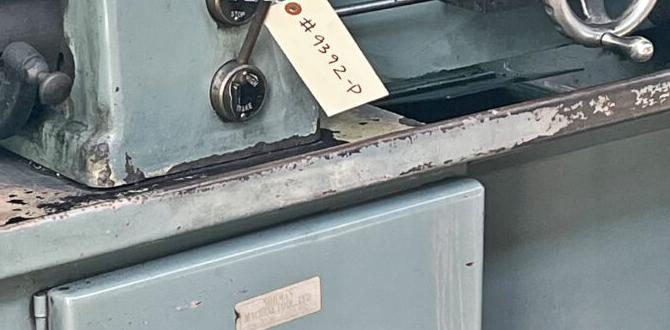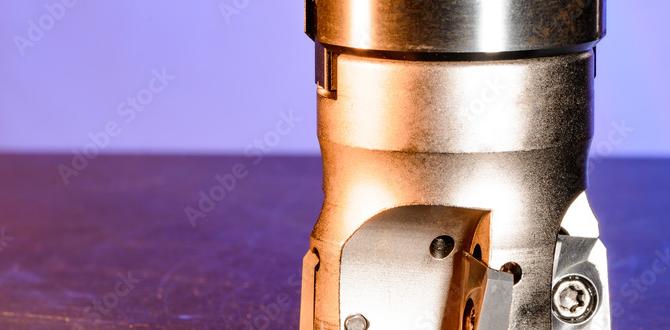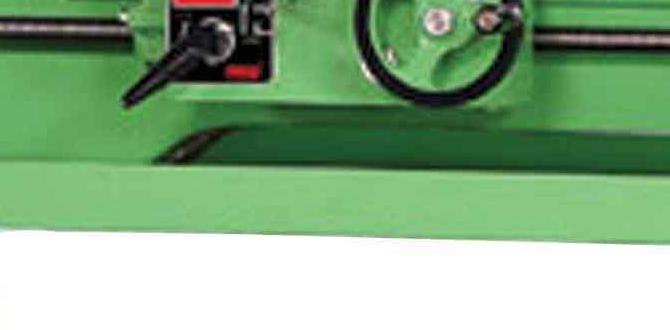Quick Summary
For lath and plaster walls, specialized anchors are crucial for securely attaching items without damaging the delicate plaster or compromising the lath. Choosing the right anchor, like toggle bolts or expanding plaster anchors, ensures a strong hold by distributing weight effectively behind the lath.
Hey everyone, Daniel Bates here from Lathe Hub! Working with lath and plaster walls can sometimes feel a bit like a delicate dance. You’ve got this beautiful old wall, and you want to hang something on it – maybe a nice shelf, a mirror, or even a cabinet. But then you realize, these aren’t your standard drywall sheets. They have a unique construction that needs a bit of extra care. Hitting a stud is always the gold standard, but what if there isn’t one where you need it? That’s where the right anchors come in. Don’t let the thought of damaging these classic walls stress you out. We’re going to walk through the best solutions, step-by-step, so you can confidently hang whatever you like, knowing it’s secure. Let’s take the guesswork out of it and get your projects looking great and staying put!
Understanding Lath and Plaster Walls
Before we dive into anchors, let’s quickly chat about what makes lath and plaster walls different from modern drywall. Think of it as a three-layer cake. The first layer is the ‘lath,’ which is usually thin strips of wood (like pine or oak) or sometimes metal mesh, laid horizontally. These strips have small gaps between them. Then, there’s the ‘plaster,’ a wet mixture of gypsum, lime, sand, and water, which is shoved into those gaps and over the lath. This creates a strong, interlocking bond. Finally, there’s usually a decorative finish layer on top. The key things to remember are that the plaster itself isn’t structural, and the gaps between the lath are important for how we’ll hang things. This construction gives these walls a solid feel, but it also means a generic screw might not hold anything heavy because it’s only gripping the plaster, which can crack and peel away.
Why Standard Anchors Often Don’t Cut It
You might be tempted to grab those self-drilling drywall anchors you’ve used a dozen times. Resist that urge! Most standard anchors are designed to work by expanding or screwing directly into drywall. They rely on the compressed material of the drywall itself to provide holding power. Lath and plaster is different. The plaster layer is often brittle, and if you just put a screw into it, it can easily crack or crumble. If you manage to get past the plaster, you’re then dealing with wood lath strips that might be old, a bit soft, or spaced unpredictably. A standard anchor might not have enough surface area to grip the back of the lath, or it might not spread its load evenly, leading to pressure points that can crack the plaster. For truly reliable support that respects the integrity of your wall, you need anchors designed to handle this specific type of construction.
The Best Anchors for Lath and Plaster: Essential Solutions
When you’re looking for anchors that will do the job right on lath and plaster, you want solutions that either spread their load over a larger area behind the wall or can reliably grip the lath itself. Here’s a breakdown of the top contenders:
1. Toggle Bolts: The Heavy-Duty Stalwarts
Toggle bolts are among the most robust options for plaster walls. They consist of a bolt with a spring-loaded ‘wing’ or ‘toggle’ attached to one end. Here’s how they work:
- You drill a hole in the plaster that’s large enough for the toggle to pass through.
- You fold the toggle flat against the bolt and insert it into the hole.
- Once behind the plaster and lath, the wings spring open, creating a large surface area that grips the back of the wall.
- You then tighten the bolt, drawing your item securely against the wall.
Pros:
- Extremely strong, capable of holding heavy items.
- Distributes weight over a wide area behind the lath and plaster.
- Excellent for attaching cabinets, shelves, or anything that needs significant support.
Cons:
- Requires a larger hole than most other anchors.
- The wings can be tricky to re-insert if they’re not held securely during installation.
- You need enough clearance behind the wall for the toggle to open.
When to use them: For significant loads like hanging heavy mirrors, large pictures, wall-mounted TVs, or kitchen cabinets. They are your go-to when you need serious holding power.
Table: Toggle Bolt Strength Comparison
| Toggle Bolt Type | Typical Hole Size | Weight Capacity (per anchor, varies by manufacturer & wall condition) | Best For |
|---|---|---|---|
| Standard Spring Toggle | 1/2″ to 1″ | 25 – 100 lbs+ | Medium to heavy items (shelves, mirrors) |
| Heavy-Duty Metal Toggle | 1″ to 2″ | 75 – 200 lbs+ | Very heavy items (cabinets, TV mounts) |
| Snap Toggle (Plastic/Metal Arms) | 3/8″ to 3/4″ | 30 – 150 lbs+ | Medium items, easier installation than springs |
2. Expanding Plaster Anchors: Clever Grippers
These anchors are specifically designed for plaster walls. They often look like a sleeve that expands as you screw into it. They work by gripping the plaster directly, but in a way that’s less likely to cause damage.
- You drill a pilot hole in the plaster.
- You insert the anchor sleeve.
- You then screw a specific screw into the sleeve. This screw has a wedge or cone at the end that forces the sleeve to expand outwards against the back of the plaster.
Pros:
- Designed for plaster, offering a good balance of strength and minimal damage.
- Generally easier to install than toggle bolts and require smaller holes.
- Good for medium-duty applications.
Cons:
- Not as strong as toggle bolts for very heavy items.
- Holding power relies heavily on the condition of the plaster. Very crumbly plaster might still be an issue.
When to use them: Ideal for hanging pictures, smoke detectors, light fixtures, or small shelves where you want a secure hold without the hassle or large hole of a toggle bolt.
3. French Cleats: The Professional’s Secret Weapon
While not strictly an “anchor” in the typical sense, a French cleat system is a fantastic way to hang heavy items on any wall, including lath and plaster. It’s a two-part system where two interlocking pieces of wood (or metal) with a bevelled edge are attached. One piece is secured to the wall (using studs or robust anchors), and the other attaches to the object you want to hang. The bevels interlock, allowing the item to hang securely and evenly distributed.
- Wall Cleat: This piece is attached to the lath and plaster wall. For maximum strength, you’ll want to screw this directly into wall studs whenever possible. If studs aren’t available, you’d use heavy-duty anchors like toggle bolts spaced along the cleat.
- Object Cleat: This piece is attached to the back of the item you wish to hang.
- The two cleats then slot together, with the weight of the object resting on the interlocking bevels.
Pros:
- Incredibly strong and distributes weight very effectively.
- Allows for easy removal and re-hanging of the item.
- Great for cabinets, heavy artwork, headboards, and more.
Cons:
- Requires woodworking skills to create or purchase pre-made systems.
- The wall cleat needs to be securely fastened, which might involve more robust attachment methods.
- Adds a slight offset from the wall.
When to use them: For heavy, large items where visual appeal and secure, easy removal are important. Think of custom kitchen cabinets, large mirrors, or headboards.
4. Wood Screws into Studs: The Foundation of Strength
This is always the most secure method, regardless of wall type. Finding and utilizing wood studs within your lath and plaster wall is the golden ticket. Studs are the vertical framing members of your wall, providing a solid wood backing.
- Locating Studs: You can use a stud finder, but be aware that older plaster walls can sometimes fool them. The classic method involves tapping the wall – a hollow sound indicates a cavity, while a solid thud suggests a stud. You can also look for subtle differences in the plaster surface or nail heads used to attach baseboards or trim. A small pilot hole drilled near the baseboard can help confirm you’ve hit solid wood. You can often find great advice on stud finding from resources like This Old House.
- Attachment: Once a stud is located, you can drill a pilot hole and drive a long wood screw directly into the stud. Ensure the screw is long enough to go through the plaster, lath, and then penetrate well into the stud itself (usually at least 1 to 1.5 inches of penetration into the wood).
Pros:
- The strongest and most reliable method available.
- Uses the structural integrity of the building itself.
- Allows for hanging very heavy items securely.
Cons:
- Requires finding the exact location of the studs, which can be challenging.
- The placement of studs limits where you can hang things.
When to use them: Anytime you are hanging something heavy and a stud is conveniently located where you need it, especially for items like heavy cabinets, shelving units, or large TVs.
5. Specialized Plaster Anchors & Mailbox Anchors
There are other anchors designed with plaster in mind. Some resemble screw anchors but have a wider flange to prevent them from pulling through the plaster. Others are often called “mailbox anchors” because they are designed for the weight that a mailbox might need to hold. These often feature a screw that drives into a metal or plastic sleeve, which then expands. Some might even have a small metal plate that sits behind the plaster to help distribute the load.
- How they work: Similar to expanding anchors, but often with a slightly different mechanism. Some might use a plastic anchor that expands, while others might use a hollow metal anchor that you screw into, and it then grips the inside of the hole.
- Considerations: Always check the weight rating and ensure the anchor is specifically recommended for plaster or lath and plaster construction.
Pros:
- Designed for plaster’s specific challenges.
- Can offer good holding power for medium-duty tasks.
- Often easier to install than toggle bolts.
Cons:
- Weight limits are typically lower than toggle bolts.
- Availability can be more niche.
When to use them: When you need something more robust than a standard drywall anchor but don’t need the full strength of a toggle bolt, and studs aren’t an option.
Step-by-Step: Installing Anchors for Lath and Plaster
Let’s walk through the general process. While the exact steps vary slightly depending on the anchor type, the core principles remain the same. Always refer to the manufacturer’s instructions for your specific anchor.
Step 1: Plan and Prepare
- Determine the Weight: Guess how much your item weighs. Then, add a little extra for good measure. This will help you select the appropriate anchor with a sufficient weight rating. For heavier items, you may need to use multiple anchors.
- Gather Your Tools: You’ll typically need:
- Your chosen anchors
- A drill with appropriately sized drill bits (masonry bits are often best for plaster)
- A pencil for marking
- A level
- A screwdriver or drill with screwdriver bits
- A tape measure
- A stud finder (optional, but recommended)
- Safety glasses (always!)
- Gloves (optional)
- Locate Studs (if possible): Use your stud finder or the tapping method. Mark the center of any studs you find in the area where you plan to hang your item.
- Mark Your Spot: Hold your item against the wall (or use a template if provided). Use a level to ensure it’s straight. Lightly mark the position for your screw holes with a pencil.
Step 2: Drill Pilot Holes
This is a critical step for lath and plaster.
- Choose the Right Bit: Check your anchor packaging. It will specify the required drill bit size. For plaster, a masonry drill bit is often best as it can handle harder surfaces without excessive chipping compared to a standard twist bit.
- Drill Carefully:
- Start drilling slowly to avoid cracking the plaster initially.
- As you drill, you’ll go through the plaster layer, then the lath. You might feel a slight change in resistance.
- For anchors like toggle bolts, you’ll need a larger hole. For expanding anchors, you’ll need a precise hole size.
- Drill to the depth recommended by the anchor manufacturer. If you’re hitting a stud, you’ll drill a smaller pilot hole for the screw into the wood.
- Clean the Hole: Remove any loose plaster dust or debris from the hole. This ensures the anchor can seat and expand properly. You can use a vacuum or a brush.
Step 3: Install the Anchor
This is where the anchor type makes the biggest difference. Here are general guidelines:
For Toggle Bolts:
- Fold the toggle wings flat against the bolt.
- Push the bolt through the hole you drilled.
- Once the toggle is through, let it spring open behind the plaster/lath.
- Gently pull the bolt outwards to set the toggle firmly against the back of the wall.
- Hold the bolt head in place (you may need pliers for larger toggles) and tighten the nut or screw to draw it snug.
- Do NOT overtighten, as this can crack the plaster.
For Expanding Plaster Anchors:
- Insert the plastic or metal sleeve into the pilot hole. It should fit snugly. If it’s a bit loose, you might need to use a different anchor or a bit of adhesive, but ideally, the hole size was correct.
- Insert the special screw provided with the anchor and begin to drive it in.
- As you screw, the anchor will expand behind the plaster, creating a secure grip.
- Tighten until the anchor is snug against the wall, but again, avoid overtightening.
For Wood Screws into Studs:
- Ensure your pilot hole goes into the center of the stud.
- Drive a long wood screw directly into the stud. It should feel tight and secure as it enters the wood.
- The screw will pass through the plaster and lath and into the stud.
For French Cleats:
- Secure the wall cleat to the wall. If using studs, drive screws directly into studs with adequate length. If not using studs, install heavy-duty anchors (like toggle bolts) at regular intervals along the cleat’s length, ensuring they are securely seated. Use a level to ensure the cleat is perfectly horizontal.
- Attach the mating cleat to your item.
- Lift your item and hook the cleat on the item onto the cleat on the wall. Check that it’s secure.
Step 4: Hang Your Item
Once your anchors are securely in place:
- Carefully align your item with the installed anchors.
- For toggle bolts and plaster anchors, you’ll typically pass the item’s mounting screw or hardware through the anchor’s protruding bolt or screw. Tighten until snug.
- For French cleats, simply hook the cleats together and ensure confidence in the fit.
- Gently test the item to ensure it’s stable.




